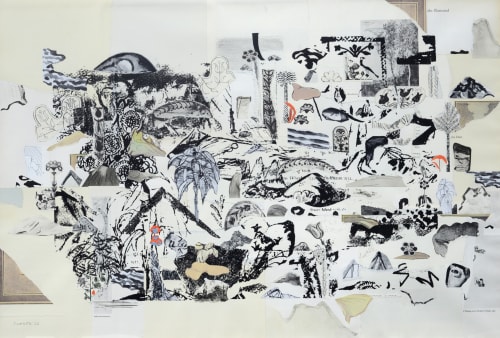An ancient mountain stands still, its rock, root, and creatures as old as time. It has settled into its ecosystem; it knows each contributing sound of life echoing through its canopies, it knows the footfalls of its natives, it knows the rain that waters it, the rivers, the pools. It feels the giving and taking of its fruit, the flora and fauna that hold the soil together.
But slowly its pebbles are washed away down the slope. The surface changes shape, its contours are not the same. Dug up, mined, weathered down. Amidst the threat of erosion there is a scramble to preserve, to hold it together, to retain its shape.
Jel Suarez works with found material—books, paper, wooden objects, stones—sourced from secondhand bookshops and thrift stores. But as these begin to be depleted, used up or lost to time, there builds a fear of losing that which gave life to her work—its very medium, the base material—the histories in these objects that could not be manufactured. After relocating away from the city, the landscape and physical distance too became more apparent, and familiar sources became inaccessible. The body of her past work, also, are glimpsed only through an indirect archive—a folder of documents, exhibit leaflet ephemera, online links, traces of a catalog. There is a struggle to grasp and arrest all the moving parts of life.
Anxious to gather this eroded material and to make it last, Held by the Surface rework elements of old pieces into new. The margins of pages, the negative space out of which images were previously cut, are pasted together to form a lattice to hold fresh ink. The shapes screenprinted on this surface are formed out of photos of old collages—themselves born of salvaged scraps—accumulating both personal and communal data. It tunnels inward, self-reflects, processing the material until all its nutrients are digested. A withered plant is broken down, its minerals absorbed from the soil, taken up through new roots, unfurling into a leaf. And the lifecycle continues.
It’s slow work to create a landscape. As the artist cuts the paper, trees, stone, organic matter gradually take shape. As she tears each page from its binding, new mountain ranges and coastlines are formed. Like a map, overlaid are the contours of images in black ink. Each piece manifests the time and attention offered in the handling of the physical material, working at life’s pace. Slowly the fear of scarcity is quelled. As the agitation settles, the sediment that was washed away forms new mounds. Nature finds an equilibrium; it persists. — Shireen Co
But slowly its pebbles are washed away down the slope. The surface changes shape, its contours are not the same. Dug up, mined, weathered down. Amidst the threat of erosion there is a scramble to preserve, to hold it together, to retain its shape.
Jel Suarez works with found material—books, paper, wooden objects, stones—sourced from secondhand bookshops and thrift stores. But as these begin to be depleted, used up or lost to time, there builds a fear of losing that which gave life to her work—its very medium, the base material—the histories in these objects that could not be manufactured. After relocating away from the city, the landscape and physical distance too became more apparent, and familiar sources became inaccessible. The body of her past work, also, are glimpsed only through an indirect archive—a folder of documents, exhibit leaflet ephemera, online links, traces of a catalog. There is a struggle to grasp and arrest all the moving parts of life.
Anxious to gather this eroded material and to make it last, Held by the Surface rework elements of old pieces into new. The margins of pages, the negative space out of which images were previously cut, are pasted together to form a lattice to hold fresh ink. The shapes screenprinted on this surface are formed out of photos of old collages—themselves born of salvaged scraps—accumulating both personal and communal data. It tunnels inward, self-reflects, processing the material until all its nutrients are digested. A withered plant is broken down, its minerals absorbed from the soil, taken up through new roots, unfurling into a leaf. And the lifecycle continues.
It’s slow work to create a landscape. As the artist cuts the paper, trees, stone, organic matter gradually take shape. As she tears each page from its binding, new mountain ranges and coastlines are formed. Like a map, overlaid are the contours of images in black ink. Each piece manifests the time and attention offered in the handling of the physical material, working at life’s pace. Slowly the fear of scarcity is quelled. As the agitation settles, the sediment that was washed away forms new mounds. Nature finds an equilibrium; it persists. — Shireen Co

